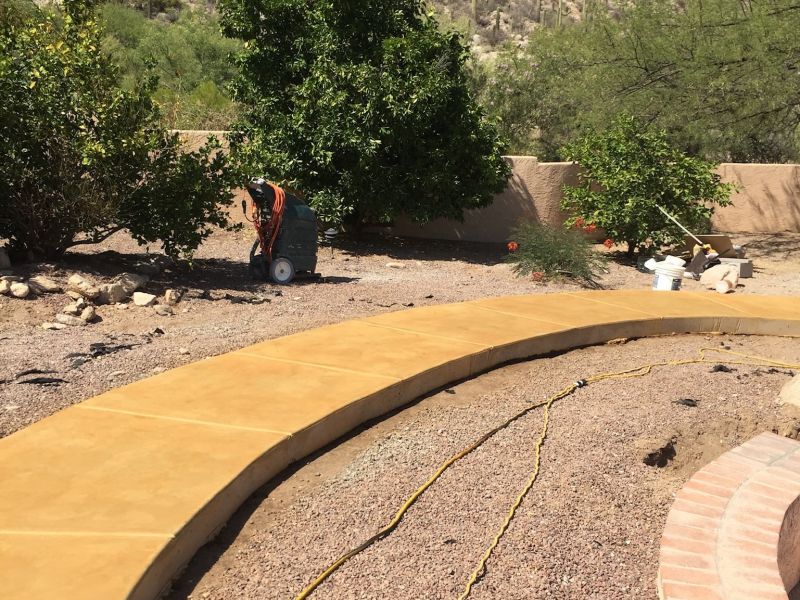
Moisture & Your Exposed Concrete
Efflorescence and moisture content are normal, intrinsic characteristics of all concrete slabs, in varying degrees, whether exposed or covered by tile or carpet or other mediums. There are many reasons for this, the principal of which is that concrete is much like a giant sponge, through which moisture and vapors constantly pass, and under certain circumstances, more freely than others. It is not unheard of for slabs to remain “wet” for a number of years after the initial pour.
The recent trend toward the use of exposed concrete as an integral and highly visible design element has merely highlighted these characteristics which would, as a matter of convention, be covered by carpet, tile or some other form of floor covering. Difficulties can arise when the functional role of the concrete slab is redefined, from a design standpoint, as a cosmetic element, instead of a supporting element. The concept is similar to using the 2×4 beams which provide support within the walls to create an exposed wood floor setting.
While certainly far from impossible, as well as probably functional to a certain degree, still subject to the limitations presented by the very nature of the material.
There are numerous variables and “unknowns” involved with moisture content and vapor emissions in the concrete slab. Compounding this difficulty is the fact that each concrete slab is as different from any other as any two people are from one another. Such variable and unknown elements include, but are not limited to:
- whether or not a sub-slab vapor barrier was placed prior to the pour
- the thickness of the slab,
- curing technique, grade/quality of concrete used,
- whether or not additional water was added to the original mix
- any other variation within the mix
- temperature and relative humidity at the time of the pour,
- purposeful (hosing or rinsing) or incidental (rainfall) post-pour saturation
High humidity, heavy rains, drainage within the surrounding landscaping, sub slab content, (for example: granite, hard-packed backfill), etc.)l, and building location (depth of water table, distance form natural/manmade washes, wells and other water sources) are also directly linked to the probability of future moisture related issues.
Obviously we are unable to warrant against moisture related issues as they are not within our scope of control or ability to predict. In addition, because moisture is a transitory variable in all concrete slabs, we have no way of predicting whether a favorable surface reading any given day will be the same in 24 hours, 24 days, or 24 weeks or months, for that matter. On occasion, slabs which have been sealed with very encouraging readings have been known to effloresce and turn white within days or weeks of sealing, sometimes requiring extensive stripping and refinishing at additional cost to the property owner. On the other hand, other slabs known to have constantly high moisture levels have been sealed without ever having shown signs of moisture related issues or required refinishing beyond that of regular maintenance.
Such unknown factors and inconsistencies can make topically finished exposed, or otherwise covered concrete a “roll of the dice” so to speak. For this reason we must evaluate each slab individually, prior to applying a sealant, and allowing for flexibility with regard to the type of sealant used. There are no guarantees as to what type and method are appropriate for any slab in that each is different. The tools, knowledge and experience we have are the best available for formulating an educated theory as to the most appropriate way to proceed.
After the concrete has been treated, all moisture and related issues become a matter of maintenance as typically associated with this type of flooring, and at the responsibility and expense of the homeowner.
Efflorescence, for instance, is the biggest issue clients with exposed, non-polished concrete floors regularly face. In some instances, this may require a periodic, aggressive neutralizing scrub. In other instances, this may require regular stripping and resealing. Again, there is no way of predicting when, or how often, such procedures will be required.
In general, exposed concrete which has been topically sealed requires annual, and in some cases, semi-annual professional maintenance. On the other end of the spectrum, some clients’ floors do not require attention for 2-3 years, or more, at a stretch. Much depends on level and type of traffic and wear, as well. Again, each slab varies. No sealant is bulletproof and all are subject to compromise by exposure to oils, acids, alkalis and various other substances commonly found within the average household, as well as exposure to the elements and uv light. For this reason, all finished concrete surfaces must be well and properly cared for and regularly maintained to minimize the effects of such damages.
In many cases, homeowners opt to have their exposed concrete floors sealed strictly with impregnating sealants in order to ensure a lower risk of complication by vapor emissions. This also leaves open the option to topically seal at a later date, obviously at an additional charge. In other cases where the client finds that time and expenses dedicated to regular repairs and maintenance are more prohibitive, the option to polish the concrete surface and treat with densifier/hardeners may be the best solution. While the initial cost and involvement of this procedure may be significantly higher, the savings with regard to refinishing and maintenance in the long range are quite considerable as this procedure virtually eliminates the need for topical sealants and headaches associated with moisture related issues. it is highly recommended that the client “do their homework”, so to speak, in order to make educated decisions regarding the treatment of their exposed concrete surfaces.
We truly hope that this information has been helpful. Please don’t hesitate to call us at 272-0815 with any further questions you or your client may have regarding the care and maintenance of their concrete floors. We look forward to hearing from you!